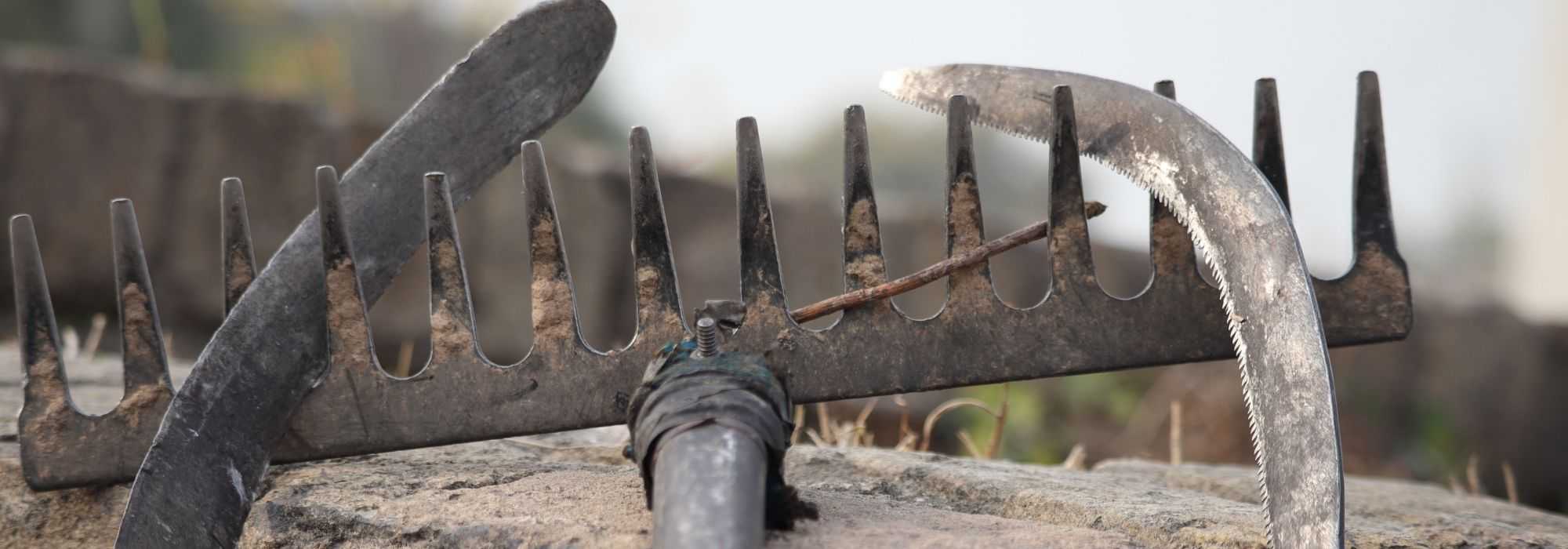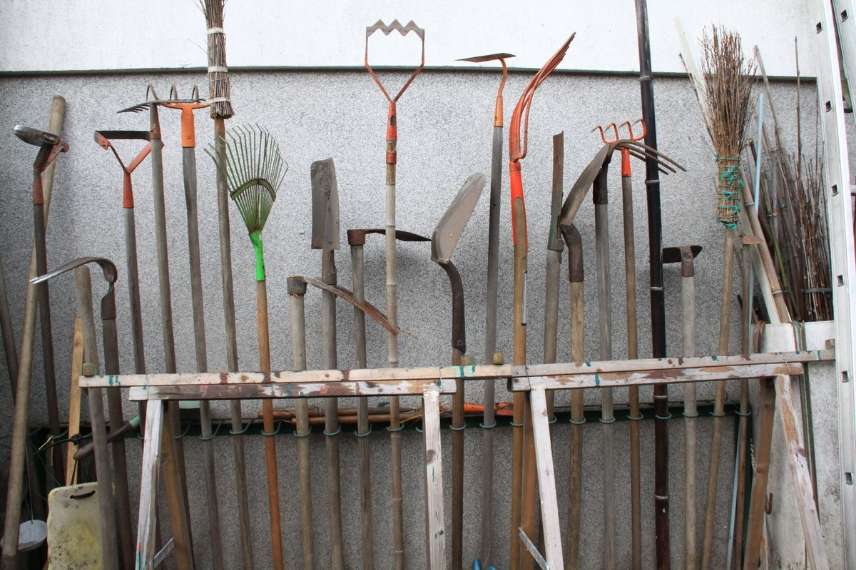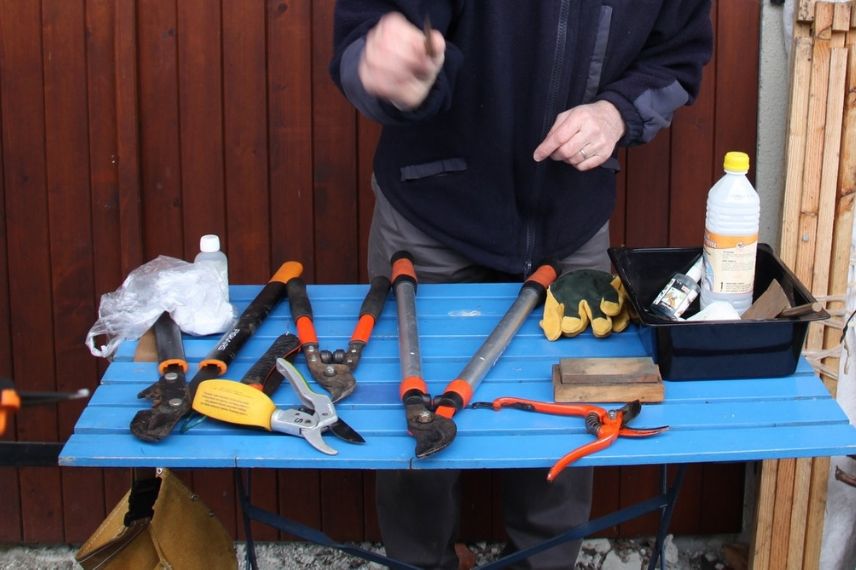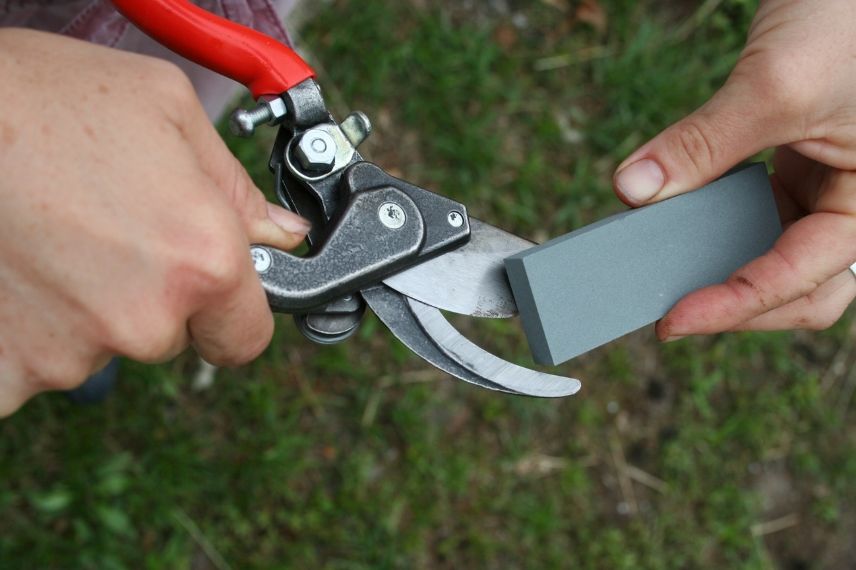
Clean, maintain and protect your garden tools
What to do before or during winter
Contents
Although it’s never too late to do things properly, early winter is the ideal time to look after our gardening tools. After all, they’ve served us all year without complaint and without us showing them the slightest care. It’s high time to put that right by making sure they quietly spend the gardener’s off-season so they’ll be fully ready when spring comes.
Here are some tips to clean, maintain and protect your garden tools, plus a few ideas to pamper them.
Why protect your tools?
Your tools are your guarantee of working with care, meticulousness and rigour in your garden. They are therefore a guarantee of good plant health and of a job well done. Dirty, rusty tools whose cutting edge is but a distant memory are a real boon for diseases that will be only too pleased to colonise your beloved plants.

Tools in perfect, clean condition are also a good way to work safely. Indeed, working with a pruning shear with blunt blades greatly increases risk of tendinitis. Similarly, a handle in poor condition will become a real time bomb destined to fail… usually fatal for the handle but perhaps for you too, who may end up sprawled in the soil of a flowerbed without further ado! Do I really need to mention that scythe blade whose fixings were forgotten and which comes loose at the first movement like a lethal boomerang?
Not to mention that ineffective tools will wear you out faster. In short, tools must be cared for or risk becoming dangerous for your health and… your nerves.
As you will have guessed, for a job well done you need the right tools, of good quality and in perfect working order. That’s why they must be looked after, especially when winter arrives.
Indeed, winter is mostly a period of calm and rest for the gardener. Tools are then put away at the back of the garden shed before returning to service as soon as crocuses start to poke up. Take advantage of this time to pamper them and check that everything is in order so you are fully ready for spring.
Read also
Garden tools: essentialsHow to clean your tools?
First of all, you will need to carefully clean your tools.
For this you will need:
- a little water
- a little black soap
- a sponge
- a small brush with stiff hair
Cleaning steps:
- start by removing all soil and other debris using a brush,
- take a sponge and some lukewarm, slightly soapy water then clean your tool thoroughly,
- dry with a clean cloth and check every crevice carefully because if you leave any trace of moisture at this stage, it will be the gateway to rust or mould.
Take your time, it’s an opportunity to sit, meditate and contemplate your achievements of the year in your garden…

Caring for wood elements
Although long used for tool handles, wood is not a fixed, inert material. That is why it continues, even today, to be used for its many qualities: the flexibility and elasticity of ash, for example, or the solidity of beech. please note: when buying your tools, check that wooden parts have no nodes and that the wood grain is not slanted, as these are weak points.
To maintain the wooden handles of your tools, you will need :
- very fine-grit sandpaper,
- linseed oil,
- cloths.
Maintenance steps for wooden handles:
- Remove any small bump or splinter using very fine-grit sandpaper, working in direction of the wood grain
- Check fixings between handle and metal head: there must be no play!
- Apply linseed oil with a rag (a piece of cloth soaked), not with a brush. Oil will penetrate wood better, nourishing and protecting it.
Never apply varnish! Varnish does not protect wood and eventually cracks. Moreover, treated this way, your tool may slip from your hands…
please note : polypropylene handles, very strong and maintenance-free, are now produced. Unfortunately, despite having many qualities, this material is neither noble nor durable. Your choice…
Maintaining metal garden features
Apart from during heavy winter cleaning, avoid wetting your tools too much. Moisture is harmful to wood (which is why long-handled tools should always be stored upright and not laid on soil) but also to metal, even if some are said to be stainless. After a good dry in the sun, you can turn to protecting the “blades” of your tools.
To maintain the “blades” of your tools, you will need:
- a wire brush,
- steel wool,
- tool grease.
Steps to clean the “blades” of your tools:
- start by brushing with a wire brush to remove the bulk,
- finish with cabinetmaker’s steel wool (grade 000) to uncover rust in the smallest crevices.
Another proven method is to soak the part to be de‑rusted for three days in a glass of fizzy soda (brand doesn’t matter!). The phosphoric acid in this brew will dissolve iron oxide, rust. It’s an effective technique but for small parts only, unless you have entire tanks of soda at your disposal…
- Then apply grease over all metal surfaces and the blades. In the past a pork rind was used, but any type of oil or grease will do: petroleum oil, tool grease… Also remember to lubricate the blade joints of your pruning shears and loppers.
- Remove this grease in spring, before first use of your tools, by rubbing with newspaper.
Sharpening blades
Blades of pruning shears, scythes, sickles and billhooks must be regularly honed (see below) using a sharpening stone previously soaked in water for a few minutes. It is best to carry out this operation at end of winter, immediately after cleaning grease from blades. This ensures all tools have an optimal edge by spring.
To maintain blades of your tools, you will need:
- a natural sharpening stone
- water

Steps to hone the blades of your tools :
- Gently rub the stone along the cutting edge of the pruning shear blades to restore the edge.
- For scythes and sickles, use a scythe stone and pass it flat along the entire length of the blade.
- Repeat until desired edge is achieved. Just remember that the sharper a blade is, the more often it will need honing.
Natural sharpening stones are to be preferred (from Lorraine quarries or the Vielsalm cuticle, for example) and must be soaked in water or oil before use for lubrication. With water, the stone will be very abrasive; with oil, the grain will seem finer. Note, however, that once a stone has been soaked in oil it can no longer be soaked in water afterwards.
please note : do not confuse sharpening and honing! Sharpening should only be carried out when the blade is blunt, about once a year. This operation requires some time. Honing is the operation used to keep a blade at its optimal edge daily or even while working (for example when using a scythe); this operation takes only a few seconds.
Tips to help your tools last longer
- Check the condition of your tools regularly. “Prevention is better than cure” and minor repairs or light maintenance are preferable to replacing a tool.
- Look after your tools by cleaning and lubricating them regularly.
- Do not leave your tools in damp conditions. Store them in a well-ventilated space and do not leave them on the ground… certainly not overnight lying in the herb!
- Buy quality! It is more expensive to buy, of course, but these tools will be more robust, more effective and longer-lasting. Some brands even offer replacement parts. Your purchase will soon pay for itself.
Did you know?
Several centuries ago, on Okinawa, peasants had to defend themselves against incursions and piracy from China, Korea, Japan and Malaya. Unfortunately, because of edicts from Japanese rule forbidding the carrying of weapons on the island, people of Okinawa had only their hands and their tools, agricultural or everyday, to defend themselves. They then invented forms of unarmed combat (To-de, which later became Karate) and various martial arts, now grouped under the name Okinawan kobudo, involving fighting with those tools. Clearly, as well as serving in their work, their tools were also their only salvation in the face of death. People of Okinawa therefore took particular care of their tools. To such an extent that some of them have survived through the centuries and are still visible today in some dojos. So be like Okinawans, take care of your garden tools…
- Subscribe!
- Contents
































Comments